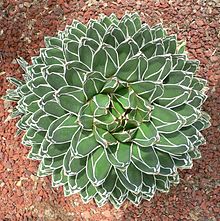Agave victoriae reginae
| Agave victoriae reginae | ||||||||||||
|---|---|---|---|---|---|---|---|---|---|---|---|---|

Agave victoriae reginae |
||||||||||||
| Systematics | ||||||||||||
|
||||||||||||
| Scientific name | ||||||||||||
| Agave victoriae reginae | ||||||||||||
| T. Moore |
Agave victoriae-reginae is a species ofthe agave genus ( agave ). The specific epithet victoriae-reginae honors the British Queen Victoria . English common names are “Royal Agave” and “Queen Victoria Agave”.
description
Agave victoriae-reginae is very variable and grows individually, with offshoots or with many heads. The compact, small rosette of leaves has no trunk or forms a short trunk when cultivated. The short, thick, rigid, linear to ovate leaves are usually closely tiled. Its tip is rounded. The underside of the leaf is rounded to sharply keeled, the top is flat to concave. The green leaf blade is 15 to 20 (rarely up to 25) inches long and 4 to 6 inches wide. It is drawn with striking white lines. The 2 to 5 millimeters wide, white horny leaf margins run through to the leaf base. Marginal teeth are usually absent. The one or three black, triangular-conical, awl- shaped terminal spines are very broad at their base. They have a length of 1.5 to 3 centimeters.
The upright, in the upper half densely flowered, "eared" inflorescence reaches a height of 3 to 5 meters. The partial inflorescences carry two to three 40 to 46 millimeter long flowers , whose strong, forked flower stalk is 40 to 46 millimeters long. The spindle-shaped thick, short-necked ovary is 18 to 24 millimeters long. The differently colored tepals are often tinged with red or purple. The shallow, funnel-shaped flower tube has a length of 3 millimeters. Their more or less identical tips are 18 to 20 millimeters long.
The number of chromosomes is 2n = 60, 120.
Systematics and distribution
Agave victoriae-reginae is in the northeast of Durango , in central Nuevo Leon and in the south of Coahuila in the desert Chihuahua in northern Mexico's endemic widespread and growing there on calcareous , often rocky ground.
The first description by Thomas Moore was published in 1875.
Synonyms are Agave victoriae-reginae f. variegata hort. (no year, nom. invalid ICBN -Article 29.1), Agave victoriae-reginae var. compacta hort. (no year, nom. invalid ICBN -Article 29.1), Agave victoriae-reginae var. stolonifera hort. (no year, nom. inval. ICBN -Article 29.1), Agave consideranti Duch. (1872), Agave nickelsiae Rol.-Goss. (1895), Agave victoriae-reginae f. nickelsiae (Rol.-Goss.) Trel. (1920), Agave victoriae-reginae var. Laxior A.Berger (1912), Agave ferdinandi-regis A.Berger (1915), Agave victoriae-reginae f. dentata widening (1960), Agave victoriae-reginae f. latifolia widening (1960), Agave victoriae-reginae f. longifolia widening (1960), Agave victoriae-reginae f. viridis widening (1960), Agave victoriae-reginae f. ornata widening (1960, nom. inval. ICBN -Article 37.1) and Agave victoriae-reginae f. stolonifera H. Jacobsen (1960, nom. inval. ICBN -Article 37.1).
The species belongs to the subgenus Littaea and is assigned to the Marginatae group. The large variety of Agave victoriae-reginae is enhanced by introgressive hybrid swarms with Agave asperrima and Agave lechuguilla .
Danger
At the request of the United States, Agave victoriae-reginae was included in Appendix II of the Washington Convention on Endangered Species on July 29, 1983 .
proof
literature
- Howard Scott Gentry : Agave victoriae-reginae . In: Agaves of Continental North America . The University of Arizona Press, 1982, pp. 183-185.
- Alejandro Martínez-Palacios, Luis E. Eguiarte, Glenn R. Furnier: Genetic diversity of the endangered endemic Agave victoriae-reginae (Agavaceae) in the Chihuahuan Desert . In: American Journal of Botany . 1999, Volume 86, pp. 1093-1098 ( PDF ).
- Joachim Thiede: Agave victoriae-reginae . In: Urs Eggli (Hrsg.): Succulent lexicon. Monocotyledons . Eugen Ulmer, Stuttgart 2001, ISBN 3-8001-3662-7 , pp. 70-71 .
Individual evidence
- ↑ Urs Eggli, Leonard E. Newton: Etymological Dictionary of Succulent Plant Names . Springer, Berlin / Heidelberg 2010, ISBN 978-3-642-05597-3 , p. 252.
- ^ Agave victoriae-reginae at Tropicos.org. In: IPCN Chromosome Reports . Missouri Botanical Garden, St. Louis
- ^ T. Moore: New Garden Plants. Agave victoriae Reginae . In: The Gardeners' Chronicle . New Series, Volume 4, 1875, pp. 484–485, Figure 101 ( online )
- ^ Howard Scott Gentry: Agave victoriae-reginae . In: Agaves of Continental North America . The University of Arizona Press, 1982, p. 185.
- ^ Proposals for amendment of Appendices I and II: Agave victoriae-reginae . CoP4 Prop. 60 ( online , accessed December 28, 2015).
- ↑ Entry ( page no longer available , search in web archives ) Info: The link was automatically marked as defective. Please check the link according to the instructions and then remove this notice. in the CITES species database (accessed June 14, 2012).
Further literature
- August J. Spread: Agave victoriae-reginae . In: The Agaves . The Cactus & Succulent Journal Yearbook, 1968, pp. 26-27.
- Thomas Heller: Agave victoriae-reginae . In: agaves . 2nd expanded edition, Münster 2006, ISBN 3937285598 , pp. 144–145.
- Mary Irish, Gary Irish: Agave victoriae-reginae . In: Agaves, Yuccas, and Related Plants: A Gardener's Guide . Timber Press, 2000, ISBN 0-88192-442-3 , pp. 176-178, plates 47-58.
- Bernd Ullrich: Agave victoriae-reginae T. Moore . In: Cacti and other succulents . Volume 41, Number 7, 1990, index card 22.

